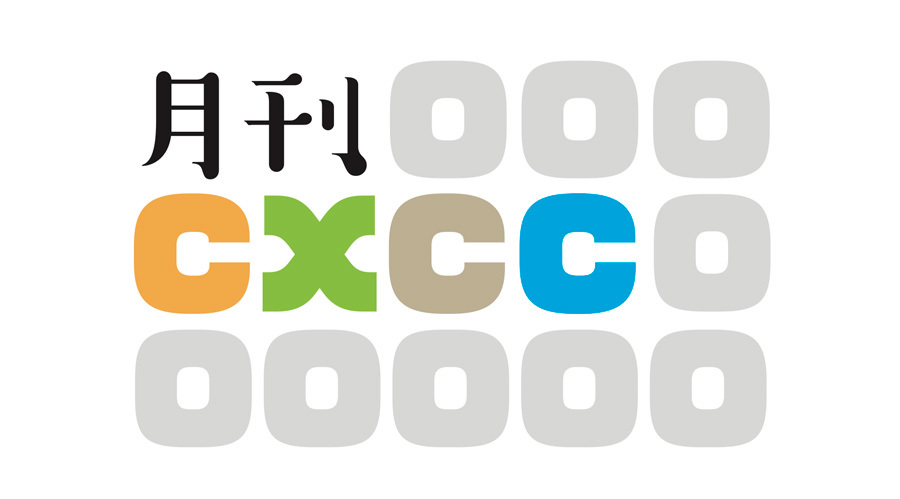CX (Customer Experience) continues to evolve daily.
How can Dentsu Inc.'s creative expertise contribute to this now ubiquitous CX domain?
To explore this potential, members of Dentsu Inc.'s CX specialist unit, the "CXCC" (Customer Experience Creative Center), share insights on CX and creativity in a serialized column. This is "Monthly CX" ( For more on Monthly CX, click here ).
This time, we spoke with four individuals: Hisashi Tanaka, the initiator of the publishing project for the book " How to Create CX Creatives " released by Dentsu Inc. CXCC on February 24, 2023, by Shoeisha; and the writing team members: Eriko Suzuki, Yasutaka Seto, and Kazuhiro Hayami.
This book offers an accessible explanation of CX Creative, covering everything from service and product development to marketing and advertising. What efforts were made leading up to its release, and what message did they aim to convey through this book?
*CX Creative refers to... using the power of creative to generate valuable new customer experiences. It also denotes the efforts undertaken to achieve this.
【Profile】
Hisashi Tanaka: Initiator of the publishing project. (※Affiliated with Dentsu CXCC at time of writing. Executive Officer at Dentsu Digital Inc. since 2023)
Kazuhiro Hayami: Creative Director. Oversaw the entire book.
Suzuki Eriko: Copywriter. Primarily responsible for Chapter 1 in this book.
Yasutaka Seto: Creative Director. Primarily responsible for Chapter 2 in this book.
Introducing CX in an easy-to-understand cookbook format
Monthly CX: Could you briefly describe the book "How to Create CX Creative" that was just released?
Tanaka: This book explains all aspects of CX, from advertising to product development, from a creative perspective. It compiles the CX know-how cultivated by Dentsu Inc. CXCC in a dialogue format, making it an accessible introductory book for beginners entering the field of CX. As a cross-functional project within the center, the CX Promotion Team, consisting of 14 members, worked together as one. It took two years from conception to publication.
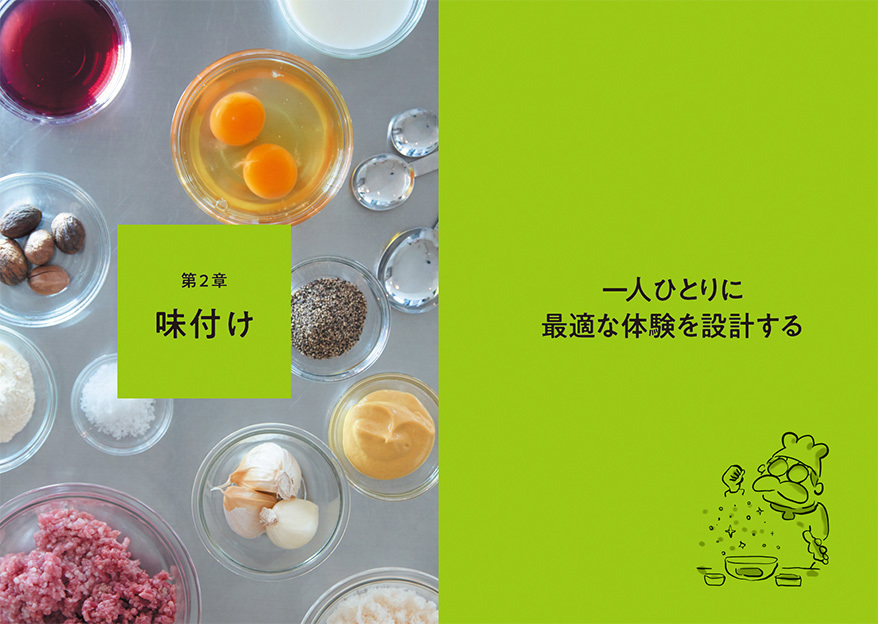
Example of a chapter cover
Hayami: A key feature of this book is its structure as a cookbook to make CX more accessible. Divided into nine chapters, it follows the steps of cooking to help readers understand CX creativity sequentially. For example, Chapter 1 covers "preparation" for designing the overall customer experience, while Chapter 2 covers "seasoning" for designing optimal experiences for each individual. The final Chapter 9, titled "Recipe Collection," also includes examples of CX creative work handled by Dentsu Inc. CXCC.
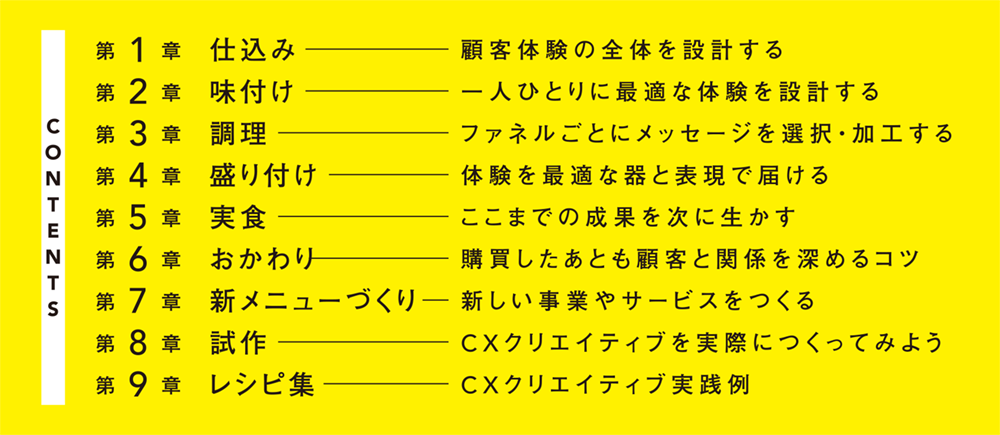
Designing content by visualizing cooking steps
Monthly CX: Framing the structure like a cookbook recipe is a very unique idea. How did you decide on this concept?
Hayami: We brainstormed as a team and decided early on. Cookbooks show the finished dish first, then explain how to make it, right? For example, you see a photo of a delicious-looking hamburger steak plated up first, followed by the ingredients and detailed instructions.
We thought that for CX creative too, rather than explaining terms and techniques in detail at the start, it would be clearer to show the final output first, like a recipe book, and then explain "Actually, this is how we made it." Also, when designing CX, the preparatory work before planning is crucial—we thought this corresponds to the "prep work" in cooking. As we thought about it this way, we ended up explaining the design process using cooking as an analogy.
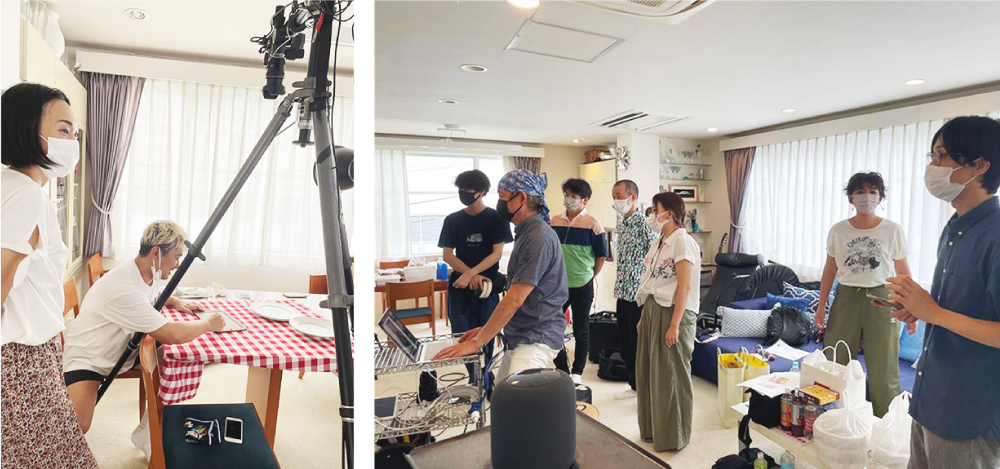
Photographing scenes for the book's images
Monthly CX: The cover design is also unique among business books—I thought it was wonderful.
Suzuki: The cover design was inspired by a red tablecloth, and the whole team agreed it was great pretty early on. But I remember when it came time to finalize the design, the publisher suggested a different option, considering how it would look compared to other business books on the shelf.
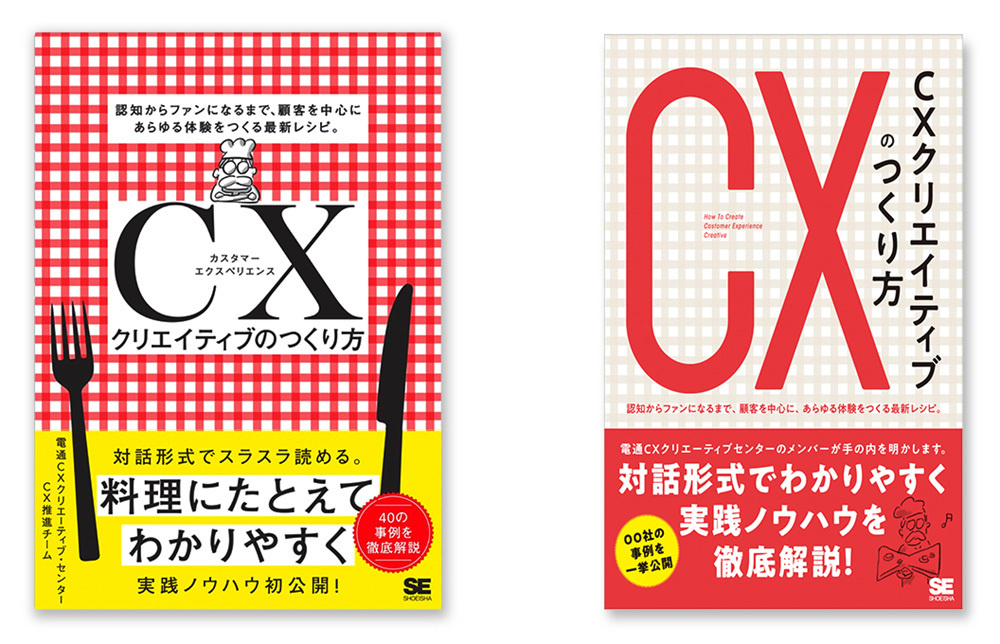
The two designs we debated until the very end
Tanaka: The discussions with the publisher were interesting too. From a design perspective, we argued that "having a cookbook visual in the business book section would make it stand out more." But the publisher suggested blending it into the shelf. They worried that a book with a red tablecloth design among business books might look out of place.
Monthly CX: Book CX design is crucial, isn't it? You were designing the CX considering the entire flow—not just the content, but also the design and display.
Seto: We incorporated many other efforts too, like making the title clearer and starting with a manga, to ensure even those unfamiliar with CX could understand. While we know CX well, talking with the publisher made us realize how little the concept of CX has permeated society yet. We had to be careful to align perspectives, ensuring our understanding of CX creative didn't diverge from what readers expected.
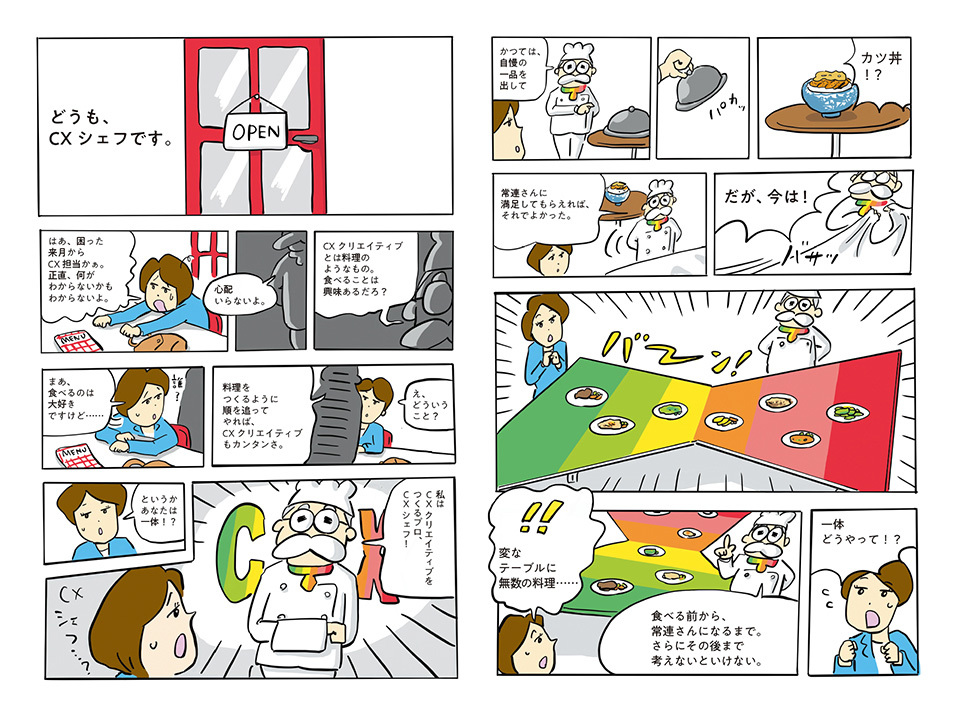
To make it more accessible to a wider audience, some sections are explained in manga format.
The approach of publishing a book as a team
Monthly CX: What was the fundamental goal behind publishing this book?
Tanaka: In a world where CX has become diverse, we strongly wanted to clearly communicate the know-how we've cultivated so far. We hoped it would be useful not only for those involved in creative work but for everyone involved in customer experience. It also had a group management aspect for the team members.
Monthly CX: Group management?
Tanaka: Essentially, strengthening collaboration. Our department brings together creators with diverse areas of expertise. We wanted to foster team development through collaborative projects with them.
Monthly CX: Did the publishing project bring about any changes within the organization?
Tanaka: I think the bonds grew stronger with every page we put into this book. It clearly led to team building—people from other departments even commented, "You guys get along really well," or "You seem to be having a lot of fun."
Seto: Filling out the content also gave us new discoveries and inspiration through discussions with members, and it improved the precision of our regular work. Everyone poured in unbelievable energy, so we feel a real sense of accomplishment.
Monthly CX: With that level of passion, surely there were challenges stemming from your dedication?
Suzuki: That's right. I was in charge of Chapter 1, "Preparation," and actually, after the members reviewed the first draft, I ended up rewriting almost the entire chapter. Members told me, "The latest CX is much broader," and figuring out how to convey that clearly became a real challenge.
Through repeated discussions with the members, we decided that when viewing CX as something broader than advertising, the crucial concept of "focusing on each individual" and its examples should be covered more extensively not just in Chapter 1, but throughout the entire book. As we challenged each other, we realized how this approach could make CX creative work appear more compelling.
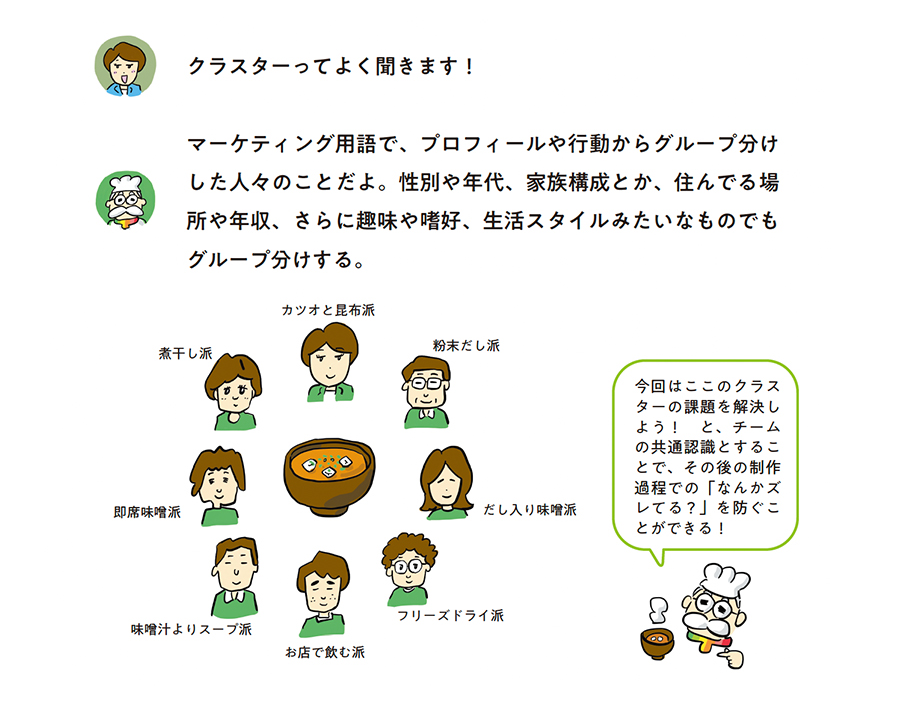
Using miso soup broth as an example, we illustrated and explained the concept of clusters.
Seto: The perspective of "focusing on each individual" is incredibly important in CX. Like Suzuki-san, I completely rewrote the beginning of Chapter 2, "Seasoning," after finishing the first draft. It was extremely tough, but I truly feel it was worth doing.
Monthly CX: Perhaps having each creator examine CX from their unique angle also broadened the team's overall perspective.
Hayami: Exactly. CX creative work evolves constantly, so parts changed daily over the two years from conception to publication—keeping up with that was tough. With new case studies emerging, it was like, "Hey, everyone, let's get this out fast!" (laughs).
The crucial commonality between cooking and CX is "focusing on people."
Monthly CX: Did you receive any reader feedback after publication?
Seto: We received feedback like, "Things I thought I vaguely understood were systematically organized and made very clear." That was the best compliment. With companies now establishing CX departments, I'd like people unsure of what to do to start by reading this book. For those already involved in CX, I'd be happy if they use it to deepen their understanding.
Hayami: My daughter works part-time at a coffee shop. She read this book and told me, "This stuff works at our place too!" That really made me happy. She seemed to see how it connects to designing the customer experience—things like service and creating the space. She understood the content and applied it to her own situation. It made me feel glad we created it.
Suzuki: Hearing that made me incredibly happy too. It showed that CX isn't confined to advertising alone—it's not a closed concept.
Monthly CX: As a reader, I was amazed at how generously you shared your accumulated know-how. There were parts where I thought, "Is it really okay to write this much?"
Tanaka: As I wrote in the book's "Afterword," just as cooking ultimately depends on the chef's skill, intuition, and experience, even with the same CX know-how, the results vary depending on the creator. Even if you know the recipe for the so-called "secret sauce," not everyone can make the same thing. I'd be delighted if those starting out in CX use this book as a foundation for building their own skills and experience.
Hayami: As I mentioned earlier, the nature of CX is changing at an incredible pace. The CX methods presented in this book are, after all, just one answer at this point in time. So, we figured, why not just lay it all out there? (laughs)
Monthly CX: Thank you. Finally, we'd like a closing word from Tanaka-san, the project's initiator.
Tanaka: When considering the connection between cooking and CX, both share the commonality of being created for someone else. In other words, both cooking and CX require a deep focus on people. Imagining, understanding, and respecting the people you want to reach is what leads to creating better CX.
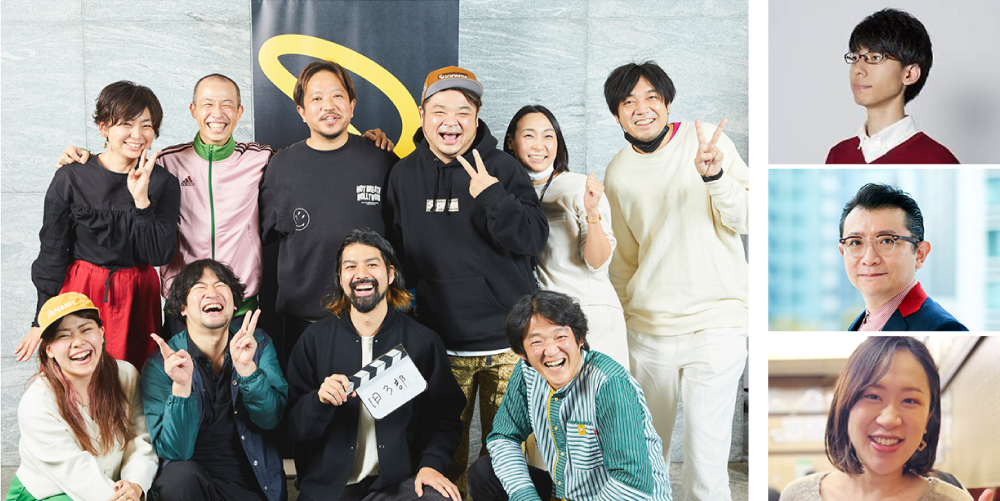
Creators involved in producing "How to Create CX Creative"
(Editor's Note)
In the 13th issue of Monthly CX, we heard about the impetus and background behind the publication of the book "How to Create CX Creative," released by Dentsu Inc. CXCC on February 24, 2023, through Shoeisha.
Whether it's cooking or CX, what matters most is observing people and imagining their needs. Adopting this perspective will enable us to create even better CX creative work going forward. This book will be a tremendous resource for everyone involved in CX creative.
This interview was conducted in collaboration with 'CX Creative Studio note' ( see here for details on CX Creative Studio note ). We've also gathered and introduced a broader range of case studies through cooperation not only with the Dentsu CXCC team but also with Dentsu Digital Inc.'s CX Creative team. If you're interested, please check that out as well.
If you have requests for future case studies or topics you'd like us to cover, please send a message to the Monthly CX Editorial Department via the contact page below. Thank you for your continued readership.














